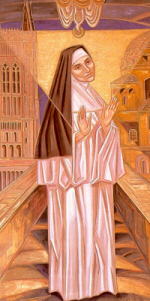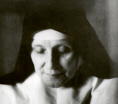See that God Has Shown Us His Face

Last Thursday, 18 April 2008, Pope Benedict XVI spoke at the Ecumenical Prayer Service held in Saint Joseph’s Church in New York City. Tomorrow the monastic calendar will commemorate a woman whose life illustrates much of what the Holy Father said. Celebrating the saints is integral to what Pope Benedict XVI calls “diachronic koinonia — communion with the Church in every age” that saves us from the narrow uncatholic perspective of the immediate here and now of a given local community.
An Offering to the Father
Blessed Maria Gabriella Sagghedu, a Cistercian nun of Grottaferrata in Italy, died on April 23rd in 1939. Pope John Paul II beatified her in 1983. In his encyclical on Christian Unity, Ut Unum Sint, he presented her again to the whole Church as a model of “the total and unconditional offering of one’s life to the Father, through the Son, in the Holy Spirit.”
Pope Benedict XVI said last Thursday that, “we must first recall that the unity of the Church flows from the perfect oneness of the triune God. In John’s Gospel, we are told that Jesus prayed to his Father that his disciples might be one, “just as you are in me and I am in you” (Jn 17:21). This passage reflects the unwavering conviction of the early Christian community that its unity was both caused by, and is reflective of, the unity of the Father, Son, and Holy Spirit.” Blessed Maria Gabriella offered her life that the unity of the Three Divine Persons might one day be manifested perfectly in the community of believers that is the Church.
Silence Turned to Praise
Blessed Maria Gabriella is one of those who, like the Blessed Virgin Mary, having heard the Word, held it in silence: in the silence of awe; in the silence that confesses God present; in the silence that allows the Word to sink into the deep and secret places of the heart. For Maria-Gabriella, this silence turned to praise: a praise that she found expressed in the priestly prayer of Christ given in the seventeenth chapter of Saint John’s Gospel. At the end of her life she murmured: “I cannot say but these words, ‘My God, your Glory.’”
A Discerning Abbess

The Trappist Cistercian monastery of Grottaferrata (moved to Vitorchiano in 1957) was governed by Mother Maria Pia Gulini (1892–1959), an intelligent and discerning abbess with a broad vision of all things Catholic. She corresponded with the Abbé Paul Couturier (1881–1953), the Apostle of Christian Unity. The Italian abbess nurtured a passion for Christian Unity and communicated that passion to her community. Maria Gabriella was receptive to Mother Gulini’s spiritual teaching. Inspired by the Holy Spirit, she asked permission of her abbess to offer her life for the Unity of Christians. The Father accepted her offering, drawing her into the prayer of Christ and into His sacrifice.
The Priestly Prayer of Christ
Blessed Maria Gabriella’s monastic life was brief; she entered the abbey of Grottaferrata in 1935 and died in 1939. She suffered from tuberculosis for fifteen months. The Bridegroom Christ came for her at the hour of the evening sacrifice on Good Shepherd Sunday. The Gospel of Mass that day had been from Saint John: “There will be one fold, and one shepherd” (Jn 10:16). After her death, her little New Testament, worn from use, opened by itself to the seventeenth chapter of Saint John’s Gospel. The pages of Jesus’ priestly prayer, so often touched by Madre Maria Gabriella’s feverish hands, had become almost transparent.
Holding Fast to Sound Teaching
Pope Benedict XVI said: “Only by “holding fast” to sound teaching (2 Thess 2:15; cf. Rev 2:12-29) will we be able to respond to the challenges that confront us in an evolving world. Only in this way will we give unambiguous testimony to the truth of the Gospel and its moral teaching. This is the message which the world is waiting to hear from us. Like the early Christians, we have a responsibility to give transparent witness to the “reasons for our hope”, so that the eyes of all men and women of goodwill may be opened to see that God has shown us his face (cf. 2 Cor 3:12-18) and granted us access to his divine life through Jesus Christ. He alone is our hope! God has revealed his love for all peoples through the mystery of his Son’s passion and death, and has called us to proclaim that he is indeed risen, has taken his place at the right hand of the Father, and “will come again in glory to judge the living and the dead” (Nicene Creed).”
Blessed Maria Gabriella held fast to the sound teaching she received from the Church through her family, her parish, and her monastic community. She bore witness to the objective truth that she experienced in the daily round of liturgical prayer to which she was faithful as long as her health allowed her to go choir. When that was no longer possible, she continued to bear witness to the objective truth actualized in the sacred liturgy by uniting herself to the Sacrifice of the Mass from her sick bed.
Madre Maria Gabriella’s humble and hidden life was itself a demonstration of the “reasons for our hope.” She contemplated the Face of God in Christ, and offered herself in sacrifice so that all Christians might find in the Catholic Church the place wherein the glory of God shining on the Face of Christ illumines all things and draws them into unity.
Unity
Blessed Maria Gabriella’s offering for Christian Unity witnesses to the fundamental thrust of every monastic life. Monastic conversion is a movement from the divided, fragmented self to the whole self, healed and unified in the love of Christ. The restoration of unity is the great monastic work; it is also the end and fruit of participation in the Holy Sacrifice of the Mass. Saint Thomas Aquinas teaches that the end proper to the sacrament of the Eucharist is the unity of the Mystical Body. Blessed Maria Gabriella, pray for us that we may go to the altar, letting go of the things that damage the unity of the Body of Christ, and ready to receive the gifts by which unity is repaired.
